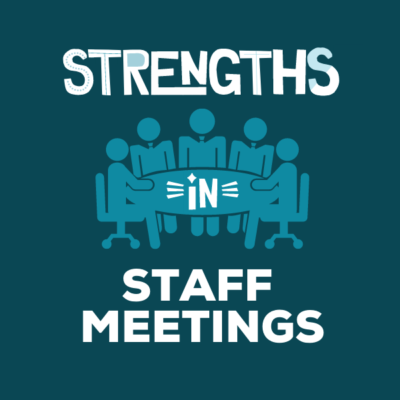3 Ways To Focus On Strengths In Staff Meetings
Podcast: Play in new window
Subscribe: Spotify | iHeartRadio | Email | TuneIn | More
Want to Incorporate Strengths In Staff Meetings?
Short conversations about strengths in team meetings can help deepen your connection with colleagues — and drive performance. With consistency and intention, imagine the exponential impact of these conversations. They drive business results.
If you’re looking to maximize your recurring time together, focus on strengths in staff meetings - a little each time. For tips on these strengths-focused conversations, listen to (or read) the podcast episode as Lisa shares three practical ideas that you can use to kickstart these activities.
 Here’s the transcript of this episode.
Here’s the transcript of this episode.
Lisa: Hey, it's Lisa Cummings from Lead Through Strengths, and in today's podcast, I'm here to do a couple of things. One is to let you know about our next upcoming quarterly public event that we do for virtual training in the realm of CliftonStrengths, that is going to be October 5. So check out leadthroughstrengths.com/events to see that. I'll give you more details at the end of the episode.
The second thing is offering you three ways to build your strengths in staff meetings. So, rather than talking about building your personal strengths, this is about ways to learn about your teammates' strengths in staff meetings. I get asked this question a lot when we do team events and people say —
How do we keep this strengths-momentum going?
How do we have these conversations about CliftonStrengths after this team training?
What should we talk about after we leave this virtual training?
How can we build StrengthsFinder into our everyday work?
Of course, I love the idea of building CliftonStrengths into everyday work because that means you're not creating a bunch of extra work. You're actually using your strengths to get existing work done in a better way. So in this episode, three ways to build strengths in staff meetings. I picked staff meetings because it's something you already have on your calendar.
For all of these tips, I love the idea of carving out 5-10 minutes at the beginning so that the meeting doesn't start running long. If you don't do it first, you can still get into all of the other agenda details and kind of forget this part because it's important but not urgent.
With that, the three ideas I have for you are:
- Love it, loathe it
- Team goals
- The hot topic
Strengths Conversation Idea 1: Love It, Loathe It
So on love it or loathe it, this is a little bit more like an exercise. The idea of it, in general, is to have each person do some thinking on something that they were really loving this week, or lately. I think lately is a really good word. What have you been loving lately? And what have you been loathing lately in terms of work?
Ask in advance so they can think of what they love or loathe before they show up, because that's just step one of it. If you want to talk about strengths in staff meetings, you want to make the meeting portion of it really efficient.
Step one of it is figuring out an answer to that question.
Then, step two would be to tie that back to your strengths so that each person can start to make these connections of what the definitions mean and how these patterns show up. These preferences show up in their thinking and their actions at work.
So that second part is really important. But if you don't give the question to them in advance and you just spring this on them, it's a little bit more difficult for people to make these connections.
An example - Imagine this team: they're new to each other, there's been a reorg, and they're all coming together. So new team members, new internal clients, a lot of new, new, new new. And as this person thinks about their answers to the question, back-to-back one-on-one meetings come up for them.
So I imagine there might be a person who leads through Individualization who says, “I've been really loving it lately. I've just been doing all kinds of one-on-ones, and I've been learning about what makes this person tick and what matters to each stakeholder.” That could be really cool for somebody who leads through Individualization. It would show up in their "love it" column.
On the flip side, that exact same situation could be on the “loathe it” list for someone who leads through Focus.
For example, they may say, “Oh my gosh, it's really been challenging my Focus talent theme to have all of these back-to-back one-on-ones. The one-on-ones themselves are fine but when I look at my calendar, and I see that it is jam-packed...back-to-back all day long...I wonder when I'm actually going to be able to sit down and crank things out and get work done. And with Focus, I really need that one or two hours of tiger time to block out the world and do my thing. I feel like it hasn't been something I've been allowing myself to do lately.
So and you can see in that example, Oh sure, maybe the same person has that ‘love it, loathe it’ side, inside of one human. But the other insight that comes out of it that's really cool is, one thing that shows up on one person's “love it” list might show up on someone else's “loathe it” list. And this starts getting everyone's wheels turning about how you can swap tasks and how you can align work that really makes a person come alive.
Tighten up the exercise - This one is a challenge to squeeze into 5 or 10 minutes. But of course you still want to incorporate strengths in staff meetings. A couple of things you can do to make sure that that time stays tight if you don't want to dedicate an entire meeting to just to this conversation:
1. Ask them to prepare their answer in advance so they have time to think about it, and
2. If you're meeting online, you can have them put their answers in the chat box when the meeting begins so that the conversation is focused on riffing off of what they already wrote in. Then you can take the conversation from there because it's fast to read each other's comments.
And then each person can go into a little more of the nuance for themselves. Of course, if you have a giant team, you can't really do the extra nuance in 5 or 10 minutes. For a typical team of 8-10 people, you can have each person add color.
Strengths Idea 2: Team Goals
The second idea for focusing on strengths in staff meetings, is team goals. And when I say team goals, I mean a goal that everyone on the team shares.
This could be a departmental goal, it could be one of those organizational pillars, it could be a thing that everyone is focused on in that functional group at work. It would be something that is really important to everyone on the team.
So if you take an example goal, "increase customer satisfaction score by 10%," how could you incorporate strengths in staff meetings and stay relevant to that team goal?
Brilliant idea, right?! You have this really specific goal that you you're already responsible for. So it's not adding work at all. Instead, it's asking the question, how can our strengths individually support this goal? Each person could share what they think they could contribute based on one or more of their strengths. And it could be something really simple, like someone might say —
You know, customers have complained in the past that we're a little bit slow to respond. So I will commit to focus my Activator on this goal so that we can really bump up the responsiveness we're offering them.
And the next person may say —
Well, we've really been detached. We haven't had close relationships.They've gotten to know 100 different team members. And now that we're assigning individual people to each account, I can really use my Relator to deepen those relationships.
And then somebody who leads through Competition might say —
Hey, I'm gonna, I'm going to be the metrics mama, and I'm going to really focus on parts of the customer satisfaction score that you might not pay attention to. But because I lead through Competition, I want to know where we stand all the time, what the best scores are, what the worst scores are, what our scores are, what other teams’ scores are, what other companies’ scores are.
So someone with Competition could really commit to having fun with that and creating a dashboard or sharing out some really fun stats or wins, that maybe other people wouldn't have noticed or seek out.
That's a really cool way to use strengths in staff meetings. You're doing something practical that you need to focus on anyway.
Strengths Idea 3: The Hot Topic
Likewise, this third idea, the hot topic, it's kind of similar, but it's more like, what's the topic of the day?
You know how either corporate communications sends out a message or the CEO sends out a message and says something like, “We need to be focused on innovation.” And that word will start waving through the organization and everybody starts talking about innovation.
So your action would be to take that hot topic, that thing that has been on everyone's lips, and use it to build strengths in staff meetings. The hot topic could be collaboration, it could be bravery, it could be situational fluency, it could be remote work, it could be being personally accountable, it could be personal leadership.
Take those kinds of topical things that come up, and spend a few minutes at the beginning of a staff meeting talking about how you could make a contribution by using your strengths and aiming it at that thing and see the vibe of it in the conversation.
It's kind of a similar flavor to #2 where we talked about team goals. But this is more focused on the hot topic of the day.
Say somebody who leads through Intellection needs to focus on remote work. The hot topic in their business unit is remote work. So if someone leads through Intellection, they might say—
Hey, when we're doing our meetings on a virtual platform, I'm going to be the one that makes sure we have an agenda beforehand and we know what we're trying to accomplish, so that people have time to do the deep thinking on the questions that are going to come up (instead of everything being in the moment), so that we can all give our best work. I’ll make sure people have time to think because of course, someone with Intellection wants that for themselves, and they know there are other people who want that for other reasons.
Let's say someone leads through Includer. They might say —
Well for remote work, I'm going to be the voice of not-lopsidedness. So I'm going to be the person who makes sure we're not always in this singular time zone where these two people get left out, or they're on the phone at 3:00AM. Or I'm going to be the person who makes sure we're sharing airtime because some people are more comfortable, and some people are less comfortable in on-video and in these virtual platforms. And so I'm going to really extend my Includer to make sure that that isn't lopsided on our team.
And someone who leads through Woo might be like —
Hey, I'm going to be the one that makes sure we are on video all the time. And it's okay if you haven't fixed your hair, but this is how we get that personal connection and we can see each other's reactions and we keep that connection as a team.
And see, of course, that matters to someone who leads through Woo. They want to be able to see how someone else is reacting. But without that person paying attention, the whole team, over time, can sort of wane on that topic.
You May Have Missed These Other Relevant Resources For Strengths-Focused Conversations In Meetings
Learning about your top strengths doesn’t stop with the StrengthsFinder 2.0 book, or CliftonStrengths training. In the episode First Step: Talking About Strengths To Get In The Zone, StrengthsFinder facilitator Joseph Dworak couldn’t stress enough the value of strengths-based conversations within teams. Nothing beats getting everyone to talk about strengths any chance there is to keep that awareness active within them.
But if you find it weird to kickstart any meeting with strengths-focused conversations, Joseph offered engaging ways you can seamlessly integrate these conversations in your meetings, or to simply create these conversations with your team. Find out more in Strengths-Based Conversations - Get ROE (Return For Effort) Today
Carmie is a professional writer and editor at Lead Through Strengths. Having spent 8 happy years with a nonprofit child organization as a storyteller and sponsorship relations team manager, she continues collaborating with others across the globe for the joy of human development and connection. Her days are powered by coffee, curiosities, cameras (film and digital), music, notebooks, and a cat. Where books are home, she’s home. She calls her Top 5 StrengthsFinder Talents “CLIPS” (Connectedness, Learner, Intellection, Positivity, and Strategic)–you know, those tiny objects that hold connected things together. She’d like to think she’s one.

